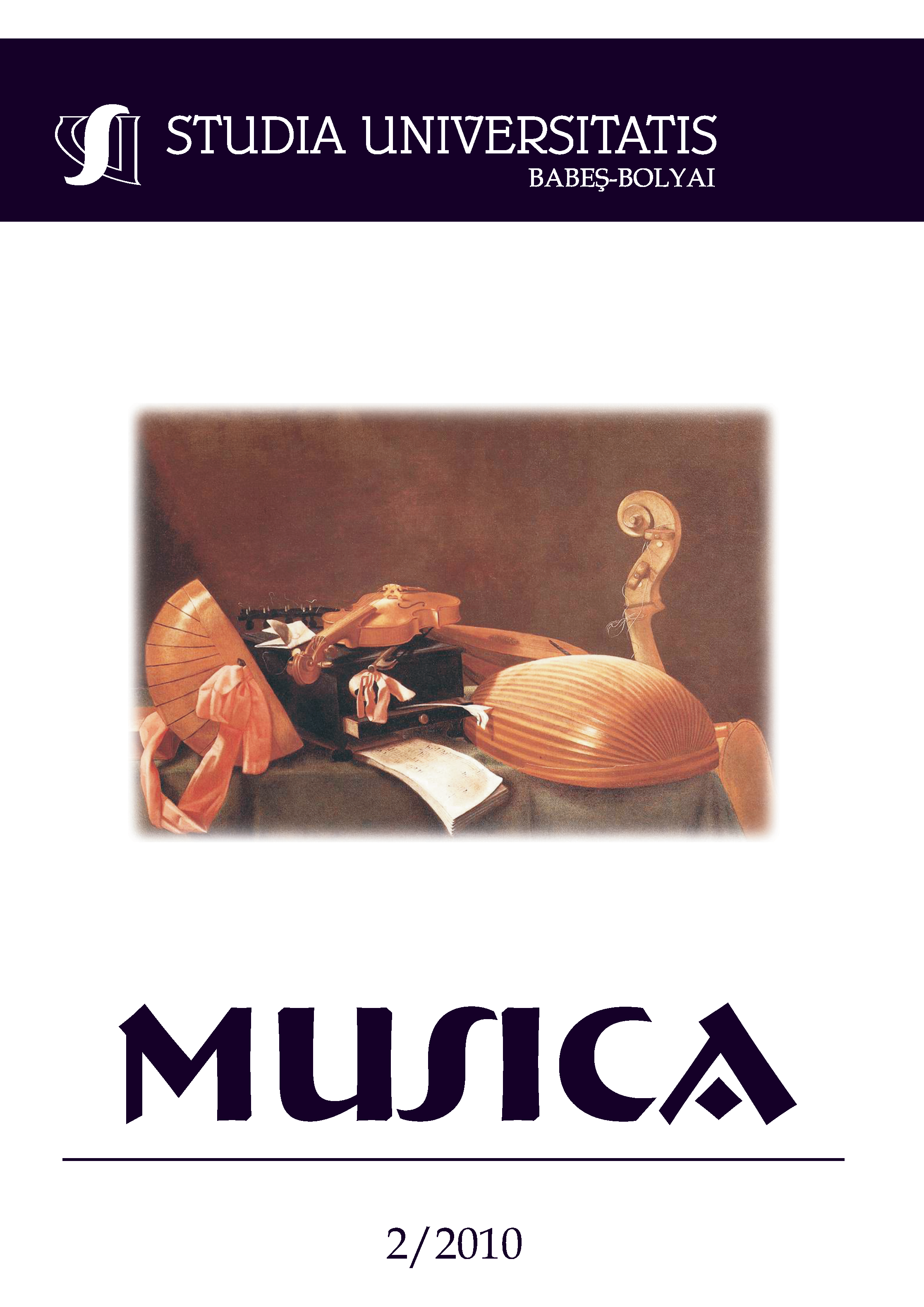FOUNDING THE SENSE FOR MUSICAL FORM IN THE CASE OF PUPILS IN PUBLIC EDUCATION
Keywords:
rhythmical structure, improvised rhythm, syllable, twin-bar, dynamic shadings, playful teaching, music, KodályAbstract
Wherever we go, whatever we do nowadays, music is present everywhere. Years ago studies proved that music has an effect on both our environment and our personality. Listening to music is not merely a pastime, a form of entertainment, an element in advertising or a means to capture our attention, but a form of manifestation of the human spirit itself. By music we can express love, joy, happiness, sorrow, inner freedom, quiet revolt, sensational or anything else that is part of the wide scale of feelings.[1]
Still, listening to contemporary works of art represents a serious challenge for every individual: the challenge of understanding musical compositions, especially the music of our times. One of the tasks of music teaching is to form a community that would not just be overwhelmed by the unintelligibility of musical pieces, but who is familiar with different musical styles and is able to interpret even unfamiliar musical pieces. It is necessary to develop in children a sense by which they will be able to understand music as a coherent process, instead of regarding it a line or set of dead sounds. Founding the development of such a sense has to start from the earliest of ages when the song performed or sung by the music teacher helps children develop a sense for musical form. In fact, the main and most basic level of a singing performance as far as developing such a sense is concerned is breathing, musical articulation and dynamic shadings.
Developing a sense for musical form means enabling pupils to understand the role the parts and elements of the piece of music play in the texture of the piece[2] and to realize how relationships between the various parts of the piece form a coherent unit, i.e. enabling the pupil to follow the logic of the musical process. Developing a sense for musical form has to begin as soon as possible.[3] And has to be continued uninterruptedly, using every suitable musical piece for this purpose.[4]
The science of musical form is one of the branches of music, which intends to develop a sense for musical form, which covers all the components of a musical piece and which requires sound knowledge.
Therefore the science of musical form is taught only in the graduating classes of music colleges or secondary schools specialized in music.
However the pedagogical principle of gradation and continuity requires that pupils should be helped to develop a sense for musical form before being introduced to the science of musical form. Still, the music course books of today deal very little with the practice of the sense for musical form.
[1] Gábor, Lajos, A zene hatása a személyiségre (The Effect of the Music on Personality) in Perspektíva, Cluj-Napoca, April 2008.
[2] Structural function
[3] Even songs consisting of G-E sounds can be formally analysed.
[4] Szenik, Ilona, A formaérzék fejlesztésének alapjai (The Basics of Developing Musical Form), In: Zenetudományi írások, ed. Benkő András, Kriterion, Budapest, 1986, 46. (Further on called: Szenik: Musical Form)
References
Almási, István,Tavaszi szél vizet áraszt (The breeze of spring’s swelling the river), Kriterion Könyvkiadó, Bukarest, 1972.
Angi, István, Zene és esztétika (Music and Aesthetics), Bukarest, 1975.
Csukáné Klimó, Mária, Játsszunk játékot, táncot, színházat (Let Us Play Games, Dancing, Performing), Régiók Magyar Tankönyvtanácsa, Kolozsvár, 2001.
Dolgoşev, M. - Marinescu, E., Educaţia muzicală în grădiniţa de copii (Music Education in Kindergarten), Editura Dictactică şi Pedagogică, Bucureşti, 1966.
Forrai, Katalin, Ének az óvodában (Music in Kingergarten), Zeneműkiadó, Budapest, 1975.
Gábor, Lajos, A zene hatása a személyiségre (The Effect of Music on Personality), In: Perspektíva, Kolozsvár, 2008. április, 9. szám.
Gárdonyi, Zoltán, Elemző formatan (The Science of Musical Form by Analysis), Zeneműkiadó Vállalat, Budapest, 1963.
Guttman, Gabriella – Mákos Albert, Ének-zene. Tankönyv az V. osztály számára (Singing and Music. A textbook for the 5th grade), Editura Didactică şi Pedagogică, Bukarest, 1972.
Halmos, Katalin – Pálffi Éva – Verestóy Ilona, Ének-zene. Tankönyv a VIII. osztály számára (Singing and Music. A textbook for the 8th grade), Editura Didactică şi Pedagogică, Bukarest, 1983.
József, Andrásné - Szmercsányi Magda, Zenei előképző I (Preparatory School for the Music School I.), Zeneműkiadó vállalat, Budapest, 1964.
Kesztler, Lőrinc, Zenei alapismeretek (The Basics in Music), Athenaeum 2000 Kiadó, Budapest, 2000.
Kocsárné Herboly, Ildikó, Többszólamúság, harmónia és forma tanítása az általános iskolában (Teaching Polyphony, Harmony and Musical Form in Primary and Middle School), Zeneműkiadó, Budapest, 1976.
Kodály, Zoltán, 333 olvasógyakorlat (333 Reading Exercises), Editio Musica, Budapest, 2003.
Kovács, Aranka – Pálffi Éva – Maxim Éva, Ének-zene. Tankönyv a VII. osztály számára (Singing and Music. A textbook for the 7th grade), Editura Didactică şi Pedagogică, Bukarest, 1983.
Kovácsné Gábor, Aranka – Maxim Éva, Ének-zene. Tankönyv a VI. osztály számára (Singing and Music. A textbook for the 6th grade), Editura Didactică şi Pedagogică, Bukarest, 1990.
László Bakk, Anikó, Egyedem-begyedem (Hickory-dickory), Kriterion Könyvkiadó, Bukarest, 1981.
Rossa, Ernő, Népdalok (Folk-songs) in Az általános iskolai énektanítás segédkönyve (The handbook of music teaching in primary and middle school), Szerk. Rossa Ernő, Tankönyv Kiadó, Budapest, 1954. (Rossa Ernő, Népdalok)
Szenik, Ilona, A formaérzék fejlesztésének alapjai (The Basics of Developing Musical Form), In: Zenetudományi írások, szerk. Benkő András, Kriterion könyvkiadó, Bukarest, 1986, pp. 46-63.
Szenik, Ilona, Népzenetudomány (The Science of Folk-Music), Erdélyi Tankönyvtanács, Kolozsvár, 1998.
Törzsök, Béla, Zenehallgatás az óvodában (Listening to Music in Kindergarten), Zeneműkiadó, Budapest, 1982.
Visnyainé Kondor, Ágnes, Módszertani javaslatok a zenei szerkesztés játékos elsajátításához (Suggestions for Methods of Playful Teaching of Musical Structures), 1982.
Downloads
Published
How to Cite
Issue
Section
License
Copyright (c) 2010 Studia Universitatis Babeș-Bolyai Musica

This work is licensed under a Creative Commons Attribution-NonCommercial-NoDerivatives 4.0 International License.



